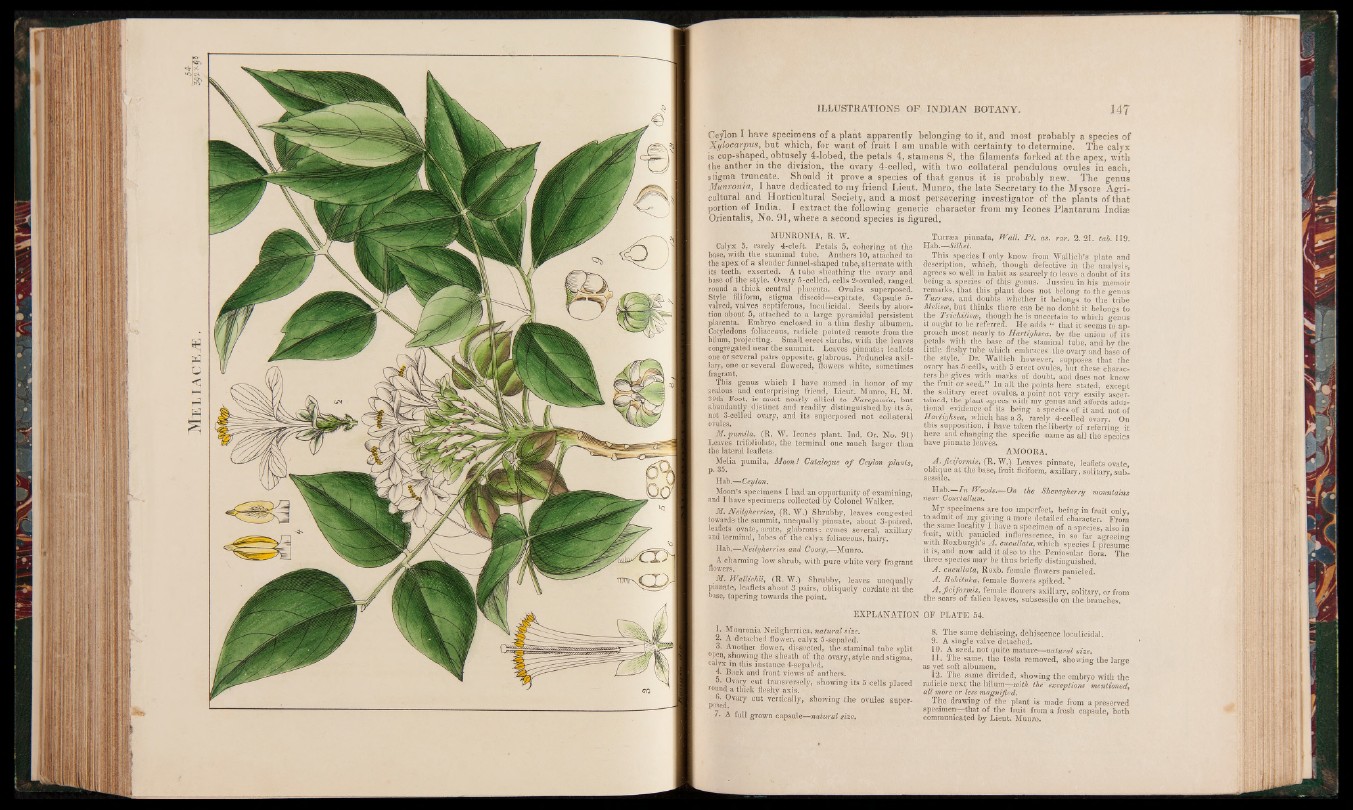
Ceylon I have specimens of a plant apparently belonging to it, and most probably a species of
X y lo c a r p u s , but which, for want of fruit I am unable with certainty to determine. The calyx
is cup-shaped, obtusely 4-lobed, the petals 4, stamens 8, the filaments forked at the apex, with
the anther in the division, the ovary 4-celled, with two collateral pendulous ovules in each,
stigma truncate. Should it prove a species of that genus it is probably new. The genus
M u n r o n ia , I have dedicated to my friend Lieut. Munro, the late Secretary to the Mysore Agricultural
and Horticultural Society, and a most persevering investigator of the plants of that
portion of India. I extract the following generic character from my leones Plantarum Indiae
Orientalis, No. 91, where a second species is figured.
MUNRONIA, R. W.
Calyx 5, rarely 4-cleft. Petals 5, cohering at the
base, with the staminal tube. Anthers 10, attached to
the apex of a slender funnel-shaped tube, alternate with
its teeth, exserted. A tube sheathing the ovary and
base of the style. Ovary 5-celled, cells 2-ovuled, ranged
round a thick central placenta. Ovules superposed.
Style filiform, stigma discoid-capitate. Capsule 5-
valved, valves septiferous, loculicidal. Seeds by abortion
about 5, attached to a large pyramidal persistent
placenta. Embryo enclosed in a tnin fleshy albumen.
Cotyledons foliaceous, radicle pointed remote from the
hilum, projecting. Small erect shrubs, with the leaves
congregated near the summit. Leaves pinnate; leaflets
one or several pairs opposite, glabrous. Peduncles axillary,
one or several flowered, flowers white, sometimes
fragrant.
This genus which I have named • in honor , of my
zealous and enterprising friend, Lieut. Munro, H. M.
39th Foot, is most nearly allied to Naregamia, but
abundantly distinct and readily distinguished by its 5,
not 3-celIed ovary, and its superposed not collateral
ovules.
M. pumila, (R. W. leones plant. Ind. Or. No. 91)
Leaves trifoliolate, the terminal one much larger than
the lateral leaflets,
Melia pumila, Moon! Catalogue o f Ceylon plants,
p. 35.
Hab.— Ceylon.
Moon’s specimens I had an opportunity of examining,
and I have specimens collected by Colonel Walker.
M. Neilgherrica, (R. W.) Shrubby, leaves congested
towards the summit, unequally pinnate, about 3-paired,
leaflets ovate, acute, glabrous: cymes several, “axillary
and terminal, lobes of the calyx foliaceous, hairy.
Hab.— Neilgherries and Coorg.—Munro.
A charming low shrub, with pure white very fragrant
flowers. °
M. Walhchii, (R. W.) Shrubby, leaves unequally
pinnate, leaflets about 3 pairs, obliquely cordate at the
base, tapering towards the point.
EXPLANATION
1. Munronia Neilgherrica, natural size.
2. A detached flower, calyx 5-sepaled.
3. Another flower, dissected, the staminal tube split
°pen, showing the sheath of the ovary, style and stigma,
c*dyx in this instance 4-sepaled.
4. Back and front views of anthers.
5- Ovary cut transversely, showing its 5 cells placed
round a thick fleshy axis.
posed0 7 ^ CUt vertica11^’ low in g the ovules euper-
7. A full grown capsule—natural size.
Turrsea pinnata, Wall. P i. as. rar. 2 .2 1 . tab. 119.
Hab.—Silhet.
This species I only know from Wallich’s plate and
description, which, though defective in the analysis,
agrees so well in habit as scarcely to leave a doubt of its
being a species of this genus. Jussieu in his memoir
remarks, that this plant does not belong to the genus
Turrcea, and doubts whether it belongs to the tribe
Melieee,lyut thinks there can he no doubt it belongs to
the Trichiliece, though he is uncertain to which genus
it ought to be referred. He adds “ that it seems to approach
most nearly to Hartighsea, by the union of its
petals with the base of the staminal tube, and by the
little fleshy tube which embraces the ovary and base of
the style. Dr.' Wallich however, supposes that the
ovary has 5 cells, with 5 erect ovules, but these characters
he gives with marks of doubt, and does not know
the fruit or seed.” In all the points here stated, except
the solitary erect ovules, a point not very easily ascertained,
the plant agrees with my genus and affords additional
evidence o f its being a species of it and not of
Hartighsea, which has a 3, rarely 4-celled ovary. On
this supposition, 1 have taken the liberty of referring it
here and changing the specific name as all the species
have pinnate leaves.
AMOORA.
A.ficiformis, (R. W.) Leaves pinnate, leaflets ovate,
oblique at the base, fruit ficiform, axillary, solitary, sub-
sessile.
Hab.—I n Woods.— On the Shevagherry mountains
near Courtallum.
My specimens are too imperfect, being in fruit only,
to admit of my giving a more detailed character. From
the same locality I have a specimen of a species, also in
fruit, with panicled inflorescence, in so far agreeing
with Roxburgh’s A . cucullata, which species I presume
it is, and now add it also to the Peninsulat flora. The
three species may be thus briefly distinguished.
A . cucullata, Roxb. female flowers panicled.
A . RohituJca, female flowers spiked. '
A.ficiformis, female flowers axillary, solitary, or from
the scars of fallen leaves, subsessile on the branches.
OF PLATE 54.
8. The same dehiscing, dehiscence loculicidal.
9. A single valve detached.
10. A seed, not quite mature—natural size.
11. The same, the testa removed, showing the large
as yet soft albumen.
12. The same divided, showing the embryo with the
radicle next the hilum—with the~ exceptions mentioned,
all more or less magnified.
The drawing of the plant is made from a preserved
specimen—that of the fruit from a fresh capsule, both
communicated by Lieut. Munro.